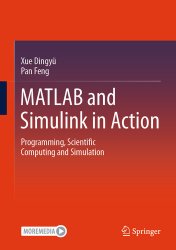 Название: MATLAB and Simulink in Action: Programming, Scientific Computing and Simulation
Название: MATLAB and Simulink in Action: Programming, Scientific Computing and SimulationАвтор: Xue Dingyü, Pan Feng
Издательство: Springer
Год: 2024
Страниц: 472
Язык: английский
Формат: pdf (true), epub
Размер: 118.0 MB
The textbook is intended for teaching MATLAB language and its applications. MATLAB language is the most widely used computer languages in scientific computing, automatic control and system simulation. The book is composed of three parts: MATLAB programming, scientific computing with MATLAB, and system simulation with Simulink. Since MATLAB is widely used in all fields of science and engineering, a good introduction to the language can not only help students learn how to use it to solve practical problems, but also provide them with the skills to use MATLAB independently in their later courses and research. The three parts of the book are well-balanced and tailored to the needs of engineering students, and the mathematical problems commonly encountered in engineering can be easily solved using MATLAB. This textbook is suitable for undergraduate and graduate students majoring in science and engineering.
Scientific computing problems are inevitable in scientific research. The researchers usually build up mathematical models in their research, then by solving the mathematical models, the solutions of the problems can be found. Specific knowledge is needed to build up mathematical models in certain areas. If the models are already established, the methods presented in this book can be used to find analytical or numerical solutions. A brief introduction on professional computer languages such as MATLAB is presented first in this chapter, followed by the development of MATLAB.
Before systematically learning MATLAB, the readers may already have some knowledge on other languages such as C or Fortran. Needless to say, that these computer languages play important part in science and engineering. They were also the low-level supporting language for MATLAB and similar languages. For scientists and engineers, it is not adequate to solve mathematical computing and simulation problems merely with languages such as C. C language cannot be used to derive formulas, or find analytical solutions, only numerical programs can be written. On the other hand, numerical methods in the textbooks are not always good choice in solve scientific computing problems. Besides, apart from the above limitations, if low-level programming languages are used, the program thus written may be too long to validate. Even though the results are found, sometimes they are not trust worthy, and the solutions may not be reliable. In this section, two examples are posed to demonstrate the limitations in C programming languages. It can be seen from the above examples that, low-level programming languages may have potential bugs in solving scientific computing problems. Therefore, simpler and more reliable dedicated computer languages such as MATLAB should be adopted in scientific research, since the researcher can be freed from trivial things, so as to master better to problems to be solved, and avoid knowledge bias. This is of course the most widely accepted methodology for the researchers.
MATLAB language can be regarded as a universal programming language. Compared with other computer languages, MATLAB has the following advantages:
(1) Concise and efficiency. MATLAB language is a highly integrated language. The statements are concise. It comes with powerful built-in facilities, such that tens or hundreds lines of source code in ordinary C or Fortran can be solved with a couple of lines in MATLAB. It is highly reliable and easy to maintain. The efficiency in solving scientific problems is significantly promoted.
(2) Facilities in scientific computing. Complex matrices are used as the basic units in MATLAB, such that matrix computation is straightforward. Besides, it has powerful facilities in solving directly optimization, calculus, differential equations, data processing, statistics problems directly with dedicated solvers. Symbolic framework is also supported in MATLAB, such that formula derivation and analytical solutions in mathematical problems can be made easily.
(3) Graphical facilities. With the simple and straightforward graphical facilities supported in MATLAB, and experimental and simulation data can be displayed in various forms, such as curves and surfaces. The curves and surfaces of various implicit functions can be made easily. Graphical user interfaces and Apps can also be programmed easily in MATLAB, from which universal tools are easily developed.
(4) Toolboxes and blocksets. In almost all fields in applied mathematics and control engineering fields, there are dedicated toolboxes and blocksets. These tools are usually developed by the well-known scholars with high reputation in the relevant fields. The results from the tools are reliable and trust worthy. With the rapid popularity and progress of MATLAB, more and more toolboxes appear in many other engineering fields, which promotes the application of MATLAB in many different fields.
(5) Dynamical simulation facilities. Block diagram-based modeling and simulation facilities are supported in Simulink. Complicated system models can easily be established and accurate simulation results can be found. The physical modeling facilities in Simulink allow the user to build simulation model of electrical, mechanical and control components under the same framework.
Contents:
Скачать MATLAB and Simulink in Action: Programming, Scientific Computing and Simulation
